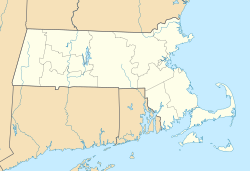Joseph K. James House | |
 Joseph K. James House | |
| Location | Somerville, Massachusetts |
|---|---|
| Coordinates | 42°23′18.53″N71°6′28.87″W / 42.3884806°N 71.1080194°W |
| Built | 1893 |
| Architect | James, Thomas M.; Farrington, Thomas F. |
| Architectural style | Queen Anne, Colonial Revival |
| MPS | Somerville MPS |
| NRHP reference No. | 98000095 [1] |
| Added to NRHP | February 11, 1998 |
The Joseph K. James House is a historic house at 83 Belmont Street in Somerville, Massachusetts. This 3 story wood-frame house was built in 1893-4 for Joseph Knightley James, a partner in a local soap manufacturer. It is one of Somerville's best examples of Queen Anne and Colonial Revival styling. It has a rectangular Colonial Revival form with a pitched hip roof, with a Queen Anne turret and chimney tops. The front porch is supported by clusters of columns and features a pedimented gable over the entry that is decorated with a hand-carved lion's head surrounded by a floral design. [2]
The house was listed on the National Register of Historic Places in 1998. [1]


